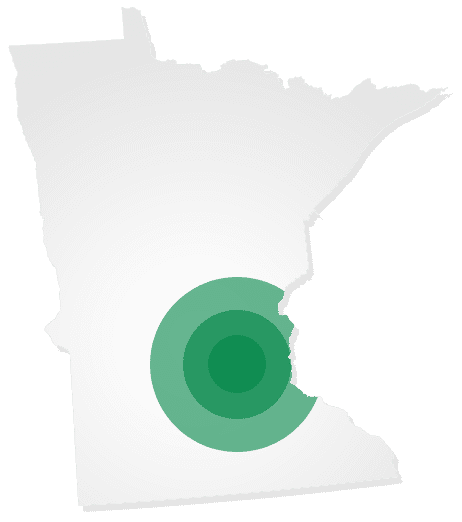Winter Damage – What it is and How to Fix It
Winter Damage – What it is and How to Fix It
As the late snow melts this year, many customers are have asked us about what kind of winter damage (aka winter kill) they should expect to see on their lawn and plants. It’s only natural to be concerned when winter seems to have extended well into spring!
Here are some common “winter melt” problems to watch for once the snow starts melting:
Snow Mold
As the snow begins to melt and lawns and yards become wet, snow mold can become apparent. In early spring, snow mold can take on the appearance of visible crusted or matted looking areas. As spring progresses, these areas remain weak and at times result in dead grass. Although snow mold can vary from year to year, conditions that cause snow mold are preventable.
There are 2 types of snow mold to look for: gray snow mold (Typhula Blight) and pink snow mold (Microdochium patch or Fusarium patch). Gray snow mold will take on a gray/white appearance whereas pink snow mold will take on a white/pink appearance.
How to Fix and Prevent Snow Mold
Unfortunately, once your lawn gets snow mold, there’s no way to prevent the grass from dying. And, there are many elemental factors that contribute to getting it. Excessive thatch, accumulation of debris, too much shade, poor drainage, and excessive snow accumulation can all contribute to snow mold.
The best way to get rid of snow mold is to prevent it from occurring in the first place. Here is a list of ways to prevent snow mold from occurring:
- Don’t let leaves or dead grass pile up on your lawn. Thick leaves and decaying grass create a perfect environment for snow mold to occur under the snow.
- Dethatch (aka vertical mowing) your lawn if the vertical layer of dead grass (thatch) is more than 3/4 inches thick.
- Use a preventative fungicide on your lawn in the fall after your last mowing to prevent spring snow mold issues.
- Large snow piles also contribute to snow mold! Although this may be unavoidable, consider dispersing the snow that you shovel or plow from your sidewalks and driveways.
- Redo landscaping to prevent problematic areas with poor soil drainage.
Winter Burn on Perennials
When the snow melts and the sun gets hotter, the signs of winter burn on perennials become visible. Foliage typically starts to brown at the tips and work its way toward the center of the plant. In some cases, it can completely kill the plant.
Pro Tip: Perennials facing south or southwest are the most affected.
How to Prevent Winter Burn
- Make sure you are planting the right type of plant for your area. Plants that are more susceptible to harsh winters are more likely to become injured.
- Equally important is to plant your perennials at the right time of the year. For Minnesota, planting in early spring or late summer are the ideal times. If you do decide to plant mid-summer, make sure your plants receive plenty of water.
- Prune your plants at the right time of year! Typically, the worst time to prune your plants are late summer to early fall. (Check out our article here to learn more.)
- Mulch around your plants properly to protect the root system of your plants throughout the winter.
- Protect your plants during the winter. If you know your plants are more susceptible to the winter elements, cover them. Burlap, canvas, barriers, or snow fencing are all options that can help prevent your plants from freezing temperatures.
- Water, water, water your plants! If your plants are new or face tougher winter elements, make they are properly watered so they do not suffer any moisture loss.
How to Fix Winter Burn
If preventing winter burn was unavoidable, or is no longer an option for you, start by pruning your plants. The best time to do this would be mid-spring after new foliage has been produced. If the branch is dead, prune back the branch until it meets with the part of the plant that is alive. Sometimes, this may require a large amount of pruning and may require several seasons before the plant fills in.
If new foliage is emerging on the tips of the branches, pruning is not required. The dead foliage should eventually fall off over the growing season. In extreme cases, the whole plant may become brown and not be salvageable. If this occurs, consider replacing the plant and follow all of the preventative measures listed above.
Vole Damage
Voles live under your lawn and feed on tree and grassroots in the winter. They tunnel beneath the surface and leave winding “trails” throughout your lawn and can cause damage during the winter months. The trails usually end up becoming brown and feel squishy when walked on. Unfortunately, these trails are harmful to your lawn, due to their shallow root systems, and can potentially kill the grass that is over them.
How to Fix and Prevent Vole Damage
Prevent moles from damaging your lawns by reducing the vole population in your yard. Things like vole repellant, bait stations, and mouse traps can be placed around your home to deter some of these pesky critters. Using a combination of these methods tends to work better than just choosing one.
When vole damage does occur, it can be fairly easy to fix. In a best-case scenario, the trails will fill in more as the growing season begins. In extreme cases, seeding may need to occur where voles have eaten away the grassroots completely.
Give it Time
Repairing lawn and plants takes time, especially when you are waiting for new growth or grass seed to begin to grow. If plants or grass are beyond repair, completely replacing the affected area will be needed. Keep in mind that even after you lay down sod or replace a perennial, proper care needs to be given to the replaced areas so that no further damage occurs. It takes time for newly populated plants and sod to establish properly in your yard! And, if you don’t want to do it yourself, or just don’t have the time, give us a call!
Looking for more information?
Call us today at 763-789-4788 to receive a free estimate on any of our property services.
Free Estimates
on all Services
Use the form below to request a free estimate on any of our services.






